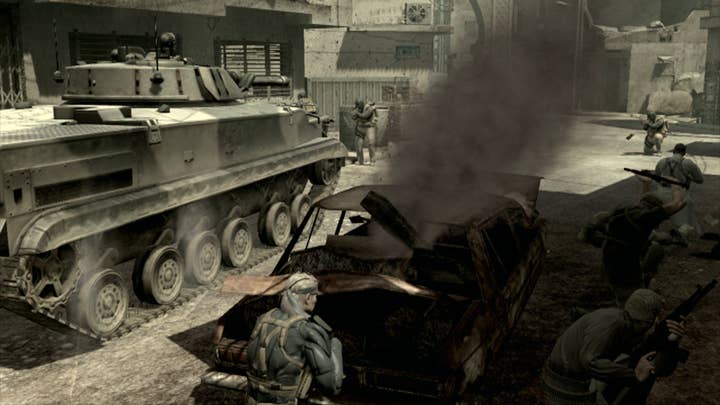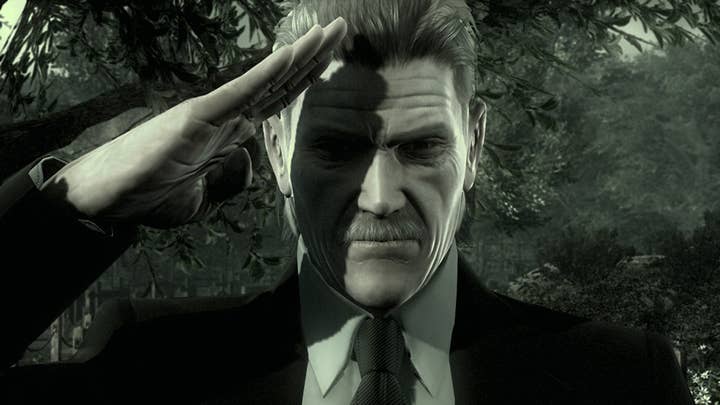The sublime theatrics and pacing of Metal Gear Solid 4 | Why I Love
Nomina Games co-founder Darrel Wijaya talks about Hideo Kojima's interactive cinematic blockbuster
Why I Love is a series of guest editorials on GamesIndustry.biz intended to showcase the ways in which game developers appreciate each other's work. This entry was contributed by Darrel Wijaya, Co-Founder of Nomina Games who are currently developing the PC old-school RPG adventure The Revenant Prince.
I've always adored games that are extremely theatrical. Subtleties of camera, movement, and dialogue can make all the difference, yet most games don't treat this filmic minutia with much care. Yet as a kid growing up in the PS3 era, there was one game that blew my mind open with how games could adopt the language of film: Metal Gear Solid 4. It was one of the first games I really sunk my teeth into, that inspired me to become the game developer I am today. Metal Gear Solid 4 was a masterpiece in fully fledged dynamic storytelling that seemed as well crafted as any film I'd experienced.
Lengthy single-player games have always been a mainstay in the medium and Metal Gear Solid 4 utilized this type of game to flex its narrative components to their maximum effect. Player character Old Snake, being a rugged aging soldier, tries to make do with his impaired physicality and fulfill his mission as perhaps the world's greatest soldier. The premise, albeit simple, is littered with breathtaking experiences and interesting gameplay mechanics that make it a remarkable title to this day, and maybe the pinnacle of director Hideo Kojima's work.
"What's so brilliant about MGS4 is that its gameplay meshes so well with the narrative, that it's almost as if the game itself was authored to play out like a classic film"
On the surface it might seem rather silly. The characters can be cheesy. The dialogue, although nicely written, can be a bit wordy, and nonsensical for new players. However, its scenes don't hold anything back when it comes to futuristic action and wartime melodrama. What's so brilliant about MGS4 is that its gameplay meshes so well with the narrative, that it's almost as if the game itself was authored to play out like a classic film.
For example, the final boss utilizes the UI as well as camera movements to pay homage to the series' history. As it shifts from the top-down perspective of old Metal Gear titles to a more contemporary behind-the-shoulder view, it signifies how both the characters and the series itself has evolved over the course of a decade.
In other words, it uses the language of film to get its themes across, even while you're actively engaged in a battle. Hideo Kojima is known for making his games play out cinematically like this, making his directorial style completely distinguishable. There are many games especially in the current era attempting to adopt such a style, however MGS4 was one of the pioneers that attempted to accomplish such a feat.

But aside from its stylistic flourishes, there was MGS4's gameplay. While heavy on story, it wanted players to feel like an active participant in the adventure. One way it did this was by allowing the player to maneuver cameras or freely switch angles during a cutscene, giving a degree of player agency and freedom to what would normally be a non-interactive exposition dump.
The meshing of gameplay and cutscenes is further blurred through an ingenious use of UI. Throughout the game Old Snake must manage a psych meter determining his mental state. So when something upsetting happens to him in a cutscene the psych meter, which is usually reserved for gameplay, pops up so we can both visualize his pain and feel it a bit ourselves, as we know we'll have to re-enter the game's survival and stealth gameplay in a weaker state.
Gameplay does feel linear at times, where players are only meant to traverse through certain prescribed paths, but this allowed Kojima tighter control to implement his cinematic flourishes.
For example, each boss fight is a uniquely crafted set piece, built around a bespoke setting that suits their lore. In one scene your AI companion Raiden is fighting antagonist Vamp atop a Metal Gear, while you must fend off incoming threats as Old Snake. To add a cinematic flair to this, the game suddenly opts for a split-screen perspective where we watch the Vamp/Raiden battle play out on one half of the screen, while we control Old Snake in the other. It can be overwhelming and difficult to pay attention to, but that's on purpose as it captures the climactic chaos of this multi-person battle.
The music also is worth mentioning, as its bombastic score feels more akin to blockbuster films of the late 2000s than a typical video game. Kojima is an ardent film buff, and his games are littered with movie references as well as thematic settings that may as well scream, "I love Western media!" Yet while the earlier games in the series had triumphant, heroic scores, MGS4 opts for something more somber and melancholic to reflect the protagonists age. At the time it was very unusual for an action game to wallow in sadness, but MGS4 took its often cheesy story seriously, and that sincerity comes across in its unwaveringly epic soundtrack.
Metal Gear Solid 4 still has a place in my heart as one of the most captivating futuristic games of its era. It tackled story and gameplay divinely on their own accord, but also cohesively as a whole unified piece. We see many games like this today, but none feel as inventive or influential to me as Metal Gear Solid 4 did all those years ago.
Developers interested in contributing their own Why I Love column are encouraged to reach out to us at news@gamesindustry.biz.
